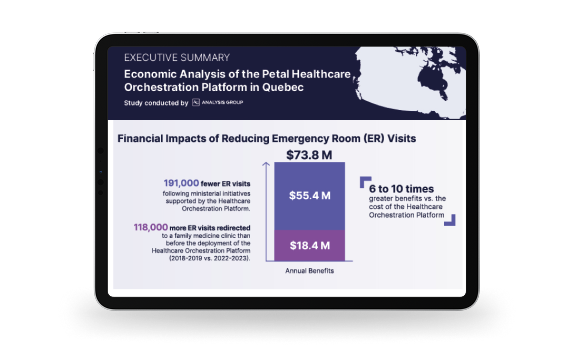Key takeaways
- In Quebec, approximately 43% of nurses leave the profession before 35 years old,
- Canada faces a shortage of 100,000+ nurses in 2030.
- Work-life balance among frontline staff must be prioritized by Department Chiefs to avoid critical challenges.
- Innovation makes nurse scheduling and shift management easier. Use to distribute shifts equitably, honor staff preferences, and automate last-minute changes based on department rules.
In a rapidly changing healthcare landscape, where the caregiver’s well-being is compromised by burnout, the core of health service delivery is at risk: high-quality patient care.
Either through needing to rush from patient to patient or nurses leaving the profession, the consequences of nurse burnout have long-ranging impact. Overworked staff and strained resources cause high turnover rates and emergency department (ED) closures. Since 2019, Canadian EDs have collectively been closed for 47,500 days, according to The Globe and Mail.
In 2024, one out of every five hospitals with an ED or urgent care centre had unplanned shutdowns. In Quebec, 43% of nurses leave the profession before 35 , and turnover rates for nurses in hospitals increased by nearly 10% in 2022 compared to pre-pandemic rates.
- Grant, K., Tu Thanh, H., & Sun, Y. (2025, July 4). The toll of Canada’s ER closure crisis. The Globe and Mail. https://www.theglobeandmail.com/canada/article-secret-canada-emergency-rooms-closures-hospitals/
- Canadian Institute for Health Information (2023). International survey shows Canada lags behind peer countries in access to primary health care. Commonwealth Fund survey. https://www.cihi.ca/en/international-survey-shows-canada-lags-behind-peer-countries-in-access-to-primary-health-care
- IEDM/MEI (2024, September 4). Quebec: 43 out of every 100 new nurses are leaving the profession before turning 35, finds new MEI report. IEDM/MEI. https://www.iedm.org/quebec-43-out-of-every-100-new-nurses-are-leaving-the-profession-before-turning-35-finds-new-mei-report/
- Greig, Kelly (2023, May 5). Turnover rates for nurses in Quebec hospitals are higher than in pre-pandemic times. CTV News. https://www.ctvnews.ca/montreal/article/turnover-rates-for-nurses-in-quebec-hospitals-are-higher-than-in-pre-pandemic-times/
Today, hospitals and other health delivery organizations (HDOs) must rethink their workforce management. Integrating technology that enhances day-to-day operations is imperative. Decision makers substantially increase their workforce output by optimizing care provider utilization. This is critical when forecasts predict that Canada will lack 100,000+ nurses by 2030.
While training and recruiting more nurses is expensive, the need is immediate. Therefore, departments should improve the work experience for their existing nurses before they feel burned out enough to leave, and this starts with fair, balanced, and sustainable shift management.
CHUM improved health staff satisfaction by 92% using Petal WFM.
Why use workforce management at your facility
Technological solutions allow decision-makers across health networks to address the dynamic demands of their workplaces. From nurses to physicians and other healthcare professionals, Petal guides each team member to their optimal location and function. This allows better alignment between frontline staff and management objectives.
Focusing on nurse shift management, Department Chiefs should choose tools tailored to nurse needs. It features automated scheduling and automated nurse callout features to streamline scheduling in real-time. These solutions help create an environment where nurses and other health professionals gain work-life balance and save more time for patients. Department Chiefs gain greater operational efficiency and adaptability.
This approach to scheduling for nurses ensures the effective utilization of staff while empowering them to consistently deliver exceptional care with increased focus and less administrative burden.
Automated nurse callout aligns with union rules and collective agreements
Baumann, A., & Crea-Arsenio, M. (2023). The crisis in the nursing labour market: Canadian policy perspectives. Healthcare (Basel), 11(13), 1954. https://doi.org/10.3390/healthcare11131954

Nurse callout solution helps cover shifts while allowing nurses to select their preferred schedules, enhancing job satisfaction and retention. This approach aligns with union rules and collective bargaining agreements, safeguarding your facility and its staff and enabling proactive staffing activities, allowing for the efficient filling of open shifts.
Through the flexibility provided by nurse callouts, teams gain agility. Tasks that used to be cumbersome, like shift assignments and publishing, are simplified by an advanced workforce management tool. This approach, designed with current healthcare challenges in mind, helps ensure both efficiency and patient care are given priority.
Automated, criteria-based callout capability for nurses identifies and alerts suitable candidates for open shifts, ensuring that vacancies are filled promptly and appropriately. This is achieved through precise time tracking, which goes beyond merely logging hours; it is crucial for providing data that enhances efficiency.
Choose smarter scheduling for nurses
Imagine a day at your health facility where scheduling is both efficient and flexible. The Petal Workforce Management solution does more than planning: it makes the management of shifts, staff, and schedules simpler and more accessible. Patients win when their caregivers can focus on caring.
- Did you know every Petal feature is designed to respect seniority and prevent conflicts?
What truly makes Petal shine is our partners’ success. For example, the University Hospital Network autonomously resolved 98% of 162+ daily change requests within one hour using Petal solutions. Tangible results like these underline our commitment to ensuring the right fit for every vacancy. This allows teams to concentrate on patient care without the stress of scheduling concerns.
We invite you to explore what Petal has to offer. Here, every shift, schedule, and callout is a step toward a healthcare delivery system that prioritizes innovation and care.
Ready to transform your team’s WFM?
1. Grant, K., Tu Thanh, H., & Sun, Y. (2025, July 4). The toll of Canada’s ER closure crisis. The Globe and Mail. https://www.theglobeandmail.com/canada/article-secret-canada-emergency-rooms-closures-hospitals/
2. Canadian Institute for Health Information (2023). International survey shows Canada lags behind peer countries in access to primary health care. Commonwealth Fund survey. https://www.cihi.ca/en/international-survey-shows-canada-lags-behind-peer-countries-in-access-to-primary-health-care
3. IEDM/MEI (2024, September 4). Quebec: 43 out of every 100 new nurses are leaving the profession before turning 35, finds new MEI report. IEDM/MEI. https://www.iedm.org/quebec-43-out-of-every-100-new-nurses-are-leaving-the-profession-before-turning-35-finds-new-mei-report/
4. Greig, Kelly (2023, May 5). Turnover rates for nurses in Quebec hospitals are higher than in pre-pandemic times. CTV News. https://www.ctvnews.ca/montreal/article/turnover-rates-for-nurses-in-quebec-hospitals-are-higher-than-in-pre-pandemic-times/
5. Baumann, A., & Crea-Arsenio, M. (2023). The crisis in the nursing labour market: Canadian policy perspectives. Healthcare (Basel), 11(13), 1954. https://doi.org/10.3390/healthcare11131954

![PT_VOMBSFP_202509_EN[1]](https://www.petal-health.com/wp-content/uploads/2025/10/PT_VOMBSFP_202509_EN1.png)
![Economicreportthumb-nobackground(1)[1]](https://www.petal-health.com/wp-content/uploads/2025/10/Economic20report20thumb-no20background2011-768x548.png)